英语阅读课教学设计
- 格式:doc
- 大小:48.50 KB
- 文档页数:5
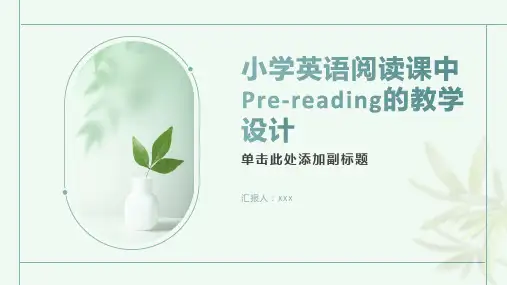
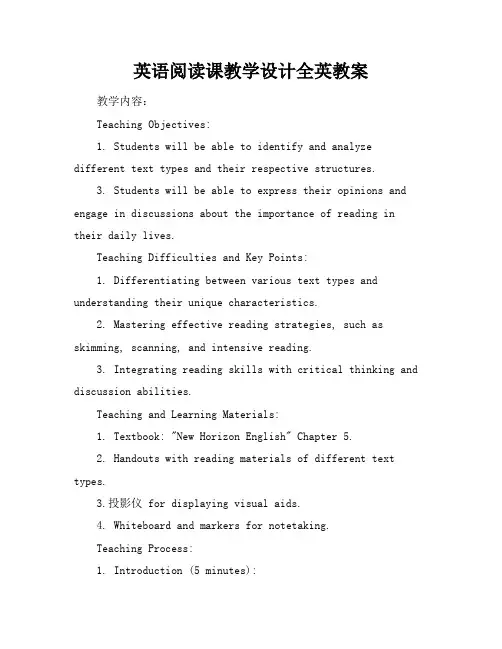
英语阅读课教学设计全英教案教学内容:Teaching Objectives:1. Students will be able to identify and analyze different text types and their respective structures.3. Students will be able to express their opinions and engage in discussions about the importance of reading in their daily lives.Teaching Difficulties and Key Points:1. Differentiating between various text types and understanding their unique characteristics.2. Mastering effective reading strategies, such as skimming, scanning, and intensive reading.3. Integrating reading skills with critical thinking and discussion abilities.Teaching and Learning Materials:1. Textbook: "New Horizon English" Chapter 5.2. Handouts with reading materials of different text types.3.投影仪 for displaying visual aids.4. Whiteboard and markers for notetaking.Teaching Process:1. Introduction (5 minutes):Engage students with a practical scenario: Discussing the last book they read and its impact on them.Introduce the importance of reading and its connection to the real world.2. Warmup (10 minutes):Review the previous chapter's key points.Conduct a brainstorming activity to elicit students' prior knowledge about different text types.3. Presentation (15 minutes):Present the structure and characteristics of eachtext type using examples from the textbook.Demonstrate effective reading strategies through an interactive slide presentation.4. Guided Practice (15 minutes):Provide students with handouts containing different text types.Discuss the answers as a class, highlighting the application of critical thinking skills.5. Independent Practice (15 minutes):Assign a short expository text for students to read independently.Encourage students to practice skimming, scanning, and intensive reading.6. Group Work (10 minutes):Divide students into groups and assign each group a text type.Ask each group to create a mind map or presentation summarizing the main points and structure of their assigned text type.Share and discuss findings among the entire class.7. Application (10 minutes):Present an argumentative text on the topic of "The Importance of Reading" to the class.Encourage students to apply the learned reading strategies and engage in a class debate.8. Summary (5 minutes):Recap the main points of the lesson, emphasizing the importance of reading and the application of effective reading strategies.Address any remaining questions or concerns from students.Board Design:1. Title: "The Power of Reading"2. Key points of each text type.3. Effective reading strategies.4. Space for writing down important notes during class discussions.Homework Design:1. Read a book or an article of their choice, focusing on one of the text types studied.2. Write a summary of the chosen text, highlighting its structure and main points.3. Answer the following question: "How does the text type affect your understanding and enjoyment of the reading material?"Lesson Reflection and Extension:1. Reflect on the effectiveness of the teaching methods used and consider adjustments for future lessons.2. Provide additional resources for students who need further practice or wish to explore more advanced reading materials.3. Plan a followup lesson on the evaluation and critical analysis of reading materials, extending students' understanding and application of the concepts learned.重点和难点解析:1. 教学难点与重点的识别。
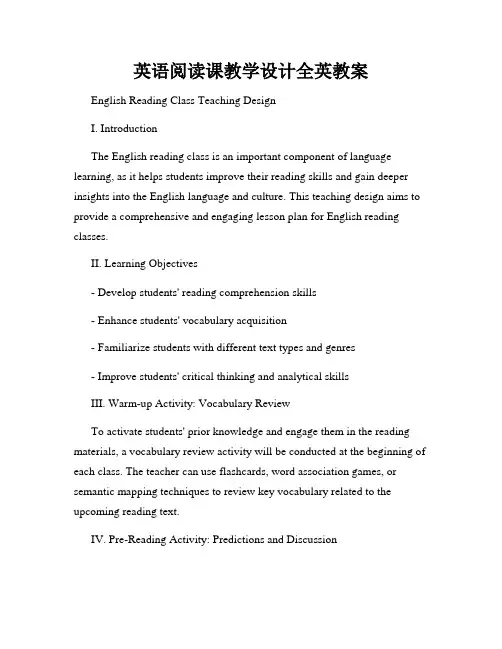
英语阅读课教学设计全英教案English Reading Class Teaching DesignI. IntroductionThe English reading class is an important component of language learning, as it helps students improve their reading skills and gain deeper insights into the English language and culture. This teaching design aims to provide a comprehensive and engaging lesson plan for English reading classes.II. Learning Objectives- Develop students' reading comprehension skills- Enhance students' vocabulary acquisition- Familiarize students with different text types and genres- Improve students' critical thinking and analytical skillsIII. Warm-up Activity: Vocabulary ReviewTo activate students' prior knowledge and engage them in the reading materials, a vocabulary review activity will be conducted at the beginning of each class. The teacher can use flashcards, word association games, or semantic mapping techniques to review key vocabulary related to the upcoming reading text.IV. Pre-Reading Activity: Predictions and DiscussionBefore diving into the main reading passage, students will be encouraged to make predictions based on the title, headlines, or visuals connected to the text. This pre-reading activity stimulates students' curiosity and prepares them for the upcoming reading tasks. Additionally, a short group or class discussion can be facilitated to activate students' background knowledge related to the topic.V. Reading Tasks1. Skimming: Students will read the text quickly to get a general understanding of the content. They will focus on identifying the main ideas, important dates, or key pieces of information within a given time limit.2. Scanning: Students will be given specific questions or statements to locate and retrieve information from the text. This activity aims to develop students' scanning skills, allowing them to find specific details efficiently.3. Detailed Reading: Students will read the text carefully and analyze the structure, style, and language used. They will answer comprehension questions, summarize paragraphs, or identify literary devices. This task promotes critical thinking and trains students to extract meaning from the text.4. Vocabulary Expansion: Throughout the reading process, students will encounter new words or expressions. In this phase, students will be guidedto infer word meanings from context, create personal vocabulary lists, and engage in vocabulary-related exercises such as word collocations, synonyms, or antonyms.VI. Post-Reading Activities1. Discussion and Reflection: After completing the main reading tasks, students will participate in a group or class discussion to share their opinions, thoughts, and reflections on the text. This activity encourages students to express themselves in English and develop their speaking and listening skills.2. Extension Activities: To further explore the text and expand students' comprehension, extension activities can be conducted, such as role-plays, debates, or creative writing tasks. These activities provide opportunities for students to apply the knowledge gained from the reading text in a practical and meaningful manner.VII. AssessmentTo evaluate students' progress and understanding, formative and summative assessments will be implemented. Formative assessments include classroom participation, group activities, and quizzes. Summative assessments may consist of reading comprehension tests, written assignments, or presentations based on the reading texts.VIII. ConclusionThis English reading class teaching design provides a systematic and engaging approach to developing students' reading skills. By incorporating various reading tasks, vocabulary expansion activities, and post-reading discussions, students will not only improve their reading comprehension but also enhance their critical thinking, analytical abilities, and overall language proficiency. This teaching design aims to create an immersive and dynamic learning environment that fosters a genuine love and appreciation for English literature and reading materials.。
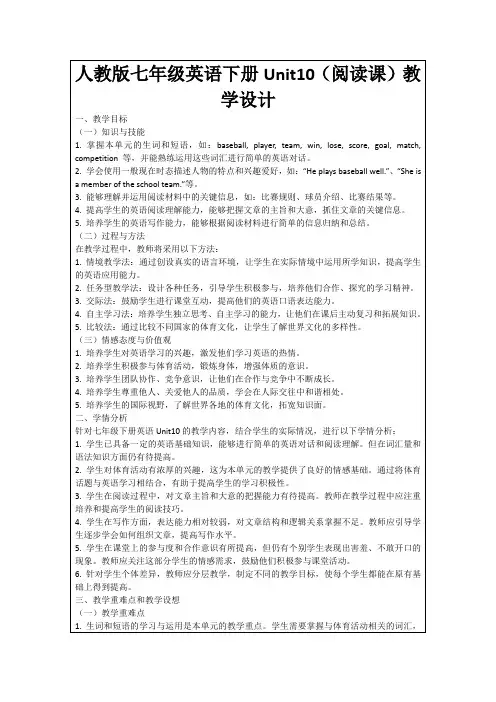
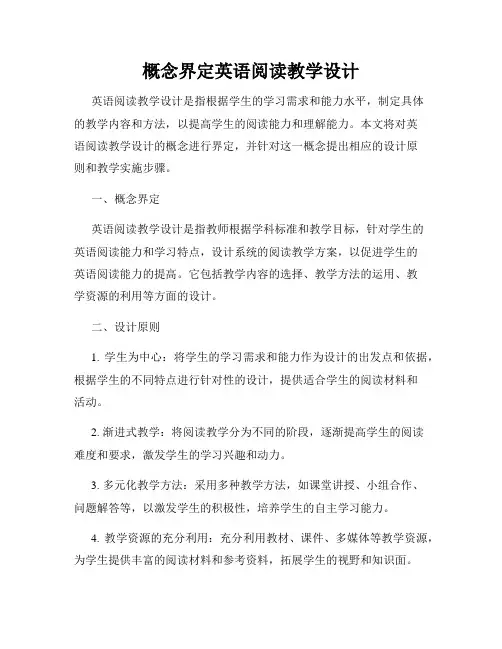
概念界定英语阅读教学设计英语阅读教学设计是指根据学生的学习需求和能力水平,制定具体的教学内容和方法,以提高学生的阅读能力和理解能力。
本文将对英语阅读教学设计的概念进行界定,并针对这一概念提出相应的设计原则和教学实施步骤。
一、概念界定英语阅读教学设计是指教师根据学科标准和教学目标,针对学生的英语阅读能力和学习特点,设计系统的阅读教学方案,以促进学生的英语阅读能力的提高。
它包括教学内容的选择、教学方法的运用、教学资源的利用等方面的设计。
二、设计原则1. 学生为中心:将学生的学习需求和能力作为设计的出发点和依据,根据学生的不同特点进行针对性的设计,提供适合学生的阅读材料和活动。
2. 渐进式教学:将阅读教学分为不同的阶段,逐渐提高学生的阅读难度和要求,激发学生的学习兴趣和动力。
3. 多元化教学方法:采用多种教学方法,如课堂讲授、小组合作、问题解答等,以激发学生的积极性,培养学生的自主学习能力。
4. 教学资源的充分利用:充分利用教材、课件、多媒体等教学资源,为学生提供丰富的阅读材料和参考资料,拓展学生的视野和知识面。
三、教学实施步骤1. 预热阶段:通过展示图片、视频等方式,引起学生对阅读主题的兴趣和好奇心,并激发学生的背景知识。
2. 导入阶段:通过教师的导入讲解,向学生介绍本节课的学习目标和内容,并提出相关问题,激活学生的思维。
3. 阅读训练阶段:提供适合学生能力水平的阅读材料,要求学生进行阅读,并进行相关的词汇和语法讲解。
教师可以给学生提供合适的阅读策略,提高学生的阅读效率和理解能力。
4. 后续活动阶段:通过小组合作、问题解答等形式,引导学生对所阅读内容进行深入的理解和思考,并进行讨论和交流。
可以设计相关的写作或翻译任务,培养学生的语言表达能力。
5. 总结评价阶段:对本节课的教学过程和学生的学习情况进行总结和评价,激发学生的自我反思和提高意识。
通过以上的教学设计,可以帮助学生提高英语阅读能力,培养学生的语言表达和沟通能力,进而提高学生的综合英语应用能力。

南京市区级小学英语绘本阅读课《A-r e d-c o a t》公开课教学设计(有配套课件)-CAL-FENGHAI-(2020YEAR-YICAI)_JINGBIAN南京市区级小学英语绘本阅读课《A red coat》公开课教学设计(有配套课件)A red coat一、教学目标1、能会说服饰类的单词,如T-shirt. coat. dress. scarf等。
以及句型Look at...和用于赞美的句式。
2、能较流利的朗读故事并能了解故事的大意。
3、能自然流利地表达故事。
4、能学会物品再利用。
二、教学重难点:1、重点:能较为流利的朗读故事并了解故意的大意。
2、难点:学生能表演故事内容。
三、情感目标:通过学习知道自己动手改造物品来帮助自己和他人。
四、教学准备:PPT、卡片,头饰等。
五、教学过程Step1. Warm up. 课前热身(1). a.Sing a song:b.Enjoy a song:(2). Free talkGood morning, boys and girls.I’m your new English teacherMr Wang.You can call my English name Jack.Well, boys and girls, as you can see, I’m Jack, I’m wearing a jacket today,it is warm, and I wanna sing aclothes song . Can you sing with me?who is wearing a jacket todayA jacket today, a jacket today. 然后引导穿与教师一样衣服的孩子站起来一起唱I’m wearing a ... today. ... today. ...today. 同法唱出coat等。
Step2. Lead in开始上课Class begins. 师生互致问候。
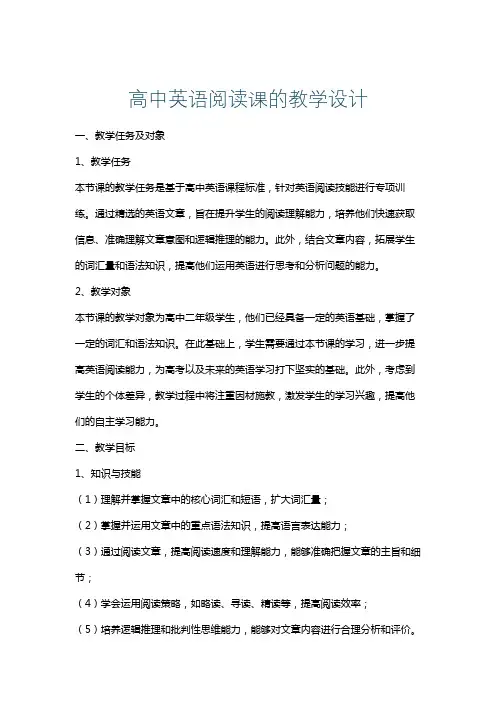
高中英语阅读课的教学设计一、教学任务及对象1、教学任务本节课的教学任务是基于高中英语课程标准,针对英语阅读技能进行专项训练。
通过精选的英语文章,旨在提升学生的阅读理解能力,培养他们快速获取信息、准确理解文章意图和逻辑推理的能力。
此外,结合文章内容,拓展学生的词汇量和语法知识,提高他们运用英语进行思考和分析问题的能力。
2、教学对象本节课的教学对象为高中二年级学生,他们已经具备一定的英语基础,掌握了一定的词汇和语法知识。
在此基础上,学生需要通过本节课的学习,进一步提高英语阅读能力,为高考以及未来的英语学习打下坚实的基础。
此外,考虑到学生的个体差异,教学过程中将注重因材施教,激发学生的学习兴趣,提高他们的自主学习能力。
二、教学目标1、知识与技能(1)理解并掌握文章中的核心词汇和短语,扩大词汇量;(2)掌握并运用文章中的重点语法知识,提高语言表达能力;(3)通过阅读文章,提高阅读速度和理解能力,能够准确把握文章的主旨和细节;(4)学会运用阅读策略,如略读、寻读、精读等,提高阅读效率;(5)培养逻辑推理和批判性思维能力,能够对文章内容进行合理分析和评价。
2、过程与方法(1)采用任务型教学法,引导学生主动参与课堂活动,提高课堂互动性;(2)利用多媒体教学资源,创设真实的语言环境,让学生在情境中学习;(3)采用小组合作学习方式,培养学生的团队协作能力和沟通能力;(4)注重启发式教学,引导学生主动思考、提问,培养自主学习能力;(5)通过课堂讲解、讨论、练习等多种教学手段,提高学生的英语阅读技能。
3、情感,态度与价值观(1)激发学生对英语阅读的兴趣,培养良好的阅读习惯;(2)引导学生树立正确的价值观,尊重不同文化,增强跨文化交际意识;(3)培养学生面对困难时,保持积极乐观的态度,勇于克服挑战;(4)通过阅读不同类型的文章,拓展学生的知识面,提高综合素质;(5)培养学生具有良好的审美情趣,学会欣赏英语语言的美。
三、教学策略1、以退为进在高中英语阅读课的教学中,采用“以退为进”的策略,即在教学过程中,教师有意识地退居次要位置,让学生成为学习的主体。
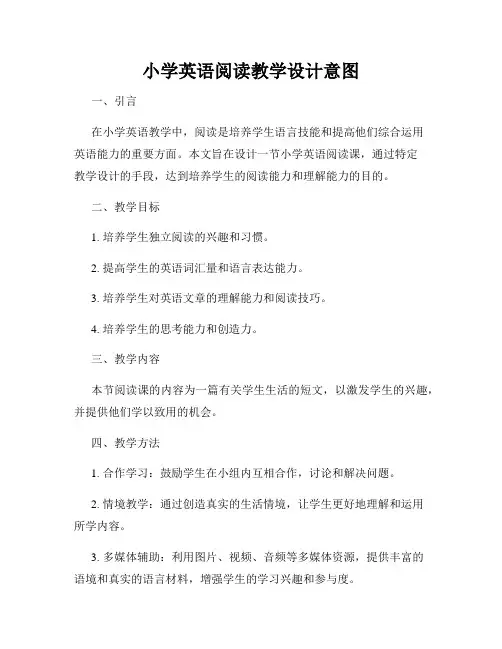
小学英语阅读教学设计意图一、引言在小学英语教学中,阅读是培养学生语言技能和提高他们综合运用英语能力的重要方面。
本文旨在设计一节小学英语阅读课,通过特定教学设计的手段,达到培养学生的阅读能力和理解能力的目的。
二、教学目标1. 培养学生独立阅读的兴趣和习惯。
2. 提高学生的英语词汇量和语言表达能力。
3. 培养学生对英语文章的理解能力和阅读技巧。
4. 培养学生的思考能力和创造力。
三、教学内容本节阅读课的内容为一篇有关学生生活的短文,以激发学生的兴趣,并提供他们学以致用的机会。
四、教学方法1. 合作学习:鼓励学生在小组内互相合作,讨论和解决问题。
2. 情境教学:通过创造真实的生活情境,让学生更好地理解和运用所学内容。
3. 多媒体辅助:利用图片、视频、音频等多媒体资源,提供丰富的语境和真实的语言材料,增强学生的学习兴趣和参与度。
五、教学步骤1. 导入:通过一些有趣的问题或图片引起学生的注意,并激发他们对即将学习的主题的兴趣。
2. 预读:给学生一些问题,让他们在阅读前先预测、猜测答案,以引发他们的思考。
3. 全文阅读:让学生通读短文,把握大意,并在必要时寻找关键词。
4. 细读:学生分组合作,根据问题和任务要求,深入理解文中的细节,回答问题或完成相关任务。
5. 讨论和分享:学生将自己的答案和观点与小组成员进行分享和讨论,并辅导老师进行必要的指导和点评。
6. 语言拓展:老师引导学生讨论文章中的词汇、短语和句型,并提供相关的语言知识和表达方式。
7. 写作训练:学生模仿短文的结构和语言,写一篇类似的短文,展示个人创造力和语言运用能力。
六、教学评估1. 学生的参与度:通过观察课堂上学生的参与和表现,评估他们在课堂上的积极程度和学习态度。
2. 学生的口头表达:通过学生在小组讨论和分享时的口头表达,评估他们对文章理解的准确性和流利程度。
3. 学生的书面表达:通过学生写作的表现,评估他们对所学语言知识的掌握和运用能力。
七、教学反思本节课通过多种教学方法和任务设计,旨在培养学生的阅读兴趣和能力。
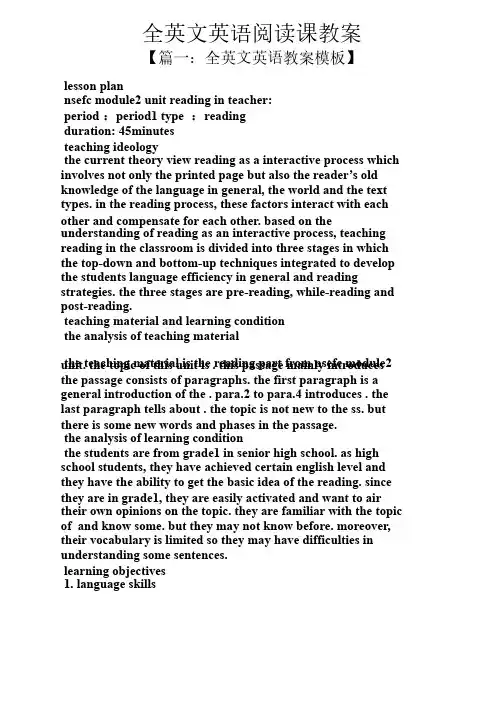
全英文英语阅读课教案【篇一:全英文英语教案模板】lesson plannsefc module2 unit reading in teacher:period:period1 type:readingduration: 45minutesteaching ideologythe current theory view reading as a interactive process which involves not only the printed page but also the reader’s old knowledge of the language in general, the world and the text types. in the reading process, these factors interact with each other and compensate for each other. based on the understanding of reading as an interactive process, teaching reading in the classroom is divided into three stages in which the top-down and bottom-up techniques integrated to develop the students language efficiency in general and reading strategies. the three stages are pre-reading, while-reading and post-reading.teaching material and learning conditionthe analysis of teaching materialthe teaching material is the reading part from nsefc module2 unit. the topic of this unit is . this passage mainly introduces the passage consists of paragraphs. the first paragraph is a general introduction of the . para.2 to para.4 introduces . the last paragraph tells about . the topic is not new to the ss. but there is some new words and phases in the passage.the analysis of learning conditionthe students are from grade1 in senior high school. as high school students, they have achieved certain english level and they have the ability to get the basic idea of the reading. since they are in grade1, they are easily activated and want to air their own opinions on the topic. they are familiar with the topic of and know some. but they may not know before. moreover, their vocabulary is limited so they may have difficulties in understanding some sentences.learning objectives1. language skillsat the beginning of the class, ss can predict the content ofthe passage based on the title. ? ss can scan the passage andfind out the specific information such as the person relatedwithss can summarize the passage with the help of the clues ofthe passage.2. language knowledgess can master the key words and phrases of the passage as follows, . ? ss can learn , especially3. affectsss will realize that and they will concern themselves with the issue of4. cultural awarenessss will broaden their minds by knowing something about 5. learning strategiesss will cultivate their ability individual learning and cooperative learning by doing someactivities independently and some in groups.ss will communicate with each other in english while doingthe group work.language difficultiesfocuses and anticipatedlanguage focusesthis is a reading period so the focus is to cultivate thestudents’ reading skills. the many activities are designed tohelp ss to train their reading skills, such as predicting, skimming, scanning and summarizing.it is also important for the ss to master the new words and phrases.anticipated difficultiesas the ss have a limited vocabulary, so they may have some difficulties in understanding the passage. so the teacher willhelp them learn the new words and phrases.ss may did not heard before, so the teacher will tell themsome background knowledge about it.teaching methodthree-stage model: based on the understanding of reading asan interactive process, teaching reading in the classroom is divided into three stages in which the top-down and bottom-up techniques integrated to develop the students languageefficiency in general and reading strategies. the three stagesare pre-reading, while-reading and post-reading.teaching aidsmultimedia devices and ppt documents: in order to help ss tofully understand the whole passage, i adopt multimediadevices and ppt documents to bring the real-life situation intothe classroom.teaching proceduresstep1. lead-in (6min)activity1. greetings and free-talking (2min)t leads into the topic by asking ss some they know. ss tell the name of the they know freely.t: hello boys and girls. (ss say hello to the teacher.)t: when we say , what appears in your minds? (ss tell thethings appear in their minds freely.) t: what are the ? (ss tell some names of .)activity2. picture-talking (4min)t shows some pictures about the in china and abroad. after seeing the pictures, ss are expected to tell the similarities of them.t: just now, you talk about some in china. now, let’s see some pictures of some . (t shows the pictures and ss see them carefully.)t: what do the have in common?for example, they are very precious. what are your opinions?(t gives them some hints and ss tell the characteristics of ) [aims]in this step, t first leads in the topic by talking with the ssfreely about the whichis familiar to them and then ss see some pictures and tell the characteristics. these two activities aim to arouse the ss’interests in the topic and activate their old knowledge of . thenss will be mentally prepared for the reading comprehension. what’s more,when they are talking about the charateristics of, they will realize that theare rare and precious and they will concern themselves with the issue of .step2. pre-reading (3min)activity1. knowing something about (1min)t gives a brief introduction of the. ss will know the t: today, weare going to learn . it is . do you know what is? (t shows some pictures ofand ss get to know the .)activity2. predicting (2min)t asks ss to read the title of the passage and then ask themsome questions. ss will predict the content of the passage withthe help of the title.t: please look at the title “”, what does “” mean?(if the ss can not give the answer, then t explain it.)t: in search means that people are looking for it. why arepeople looking for it? can you guess? what will the passagetalk about?(ss predict the content, but t will not give the answer here.)[aims]in this step, the ss first know some information of the ; the background information will make it easier for the ss tounderstand the passage. then t asks ss to make predictionsabout the passage. it aims to help ss develop the reading skillsof predicting.step3. while-reading (22min)activity1. skimming (4min)ss skim the whole passage and find out and check their predictions. t: why are people still ? here is a multiple choicefor you.activity2. scanning (3min)t presents several true or false statements and asks the ss toscan the passage and judge the right from the wrong.(keys: F,F,T,T,F)activity3 close-reading (15min)t designs various kinds of activities and ss do the activities tofully understand the passage. para.1t: please read para.1 carefully and then take some note aboutthe .para.2-4please read para.2-4 carefully and then find out the removal ofthe room.please read para.2-4 carefully and then find out the personrelated with the amber room and the things them down with it. para.5please read para.5 carefully and then find out the therebuilding of the amber room.【篇二:初中英语阅读课教学设计】谈初中英语阅读课教学案例吉林省桦甸市金沙中学:王欣平一、背景现行初中英语教材具有很多的优点,但由于学生认知水平的发展具有规律性,教师只有充分认识和掌握这种规律,并结合教学实际,合理设计教学程序,充分发挥学生的主体作用,教学相长,才能达到教学效果的最优化。
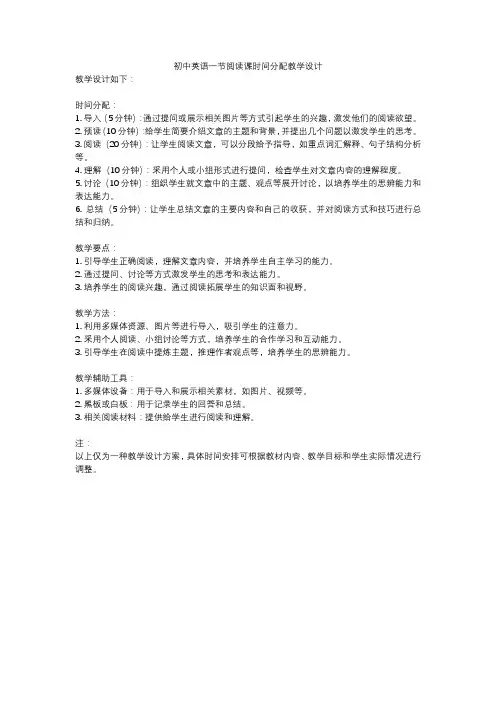
初中英语一节阅读课时间分配教学设计
教学设计如下:
时间分配:
1. 导入(5分钟):通过提问或展示相关图片等方式引起学生的兴趣,激发他们的阅读欲望。
2. 预读(10分钟):给学生简要介绍文章的主题和背景,并提出几个问题以激发学生的思考。
3. 阅读(20分钟):让学生阅读文章,可以分段给予指导,如重点词汇解释、句子结构分析等。
4. 理解(10分钟):采用个人或小组形式进行提问,检查学生对文章内容的理解程度。
5. 讨论(10分钟):组织学生就文章中的主题、观点等展开讨论,以培养学生的思辨能力和表达能力。
6. 总结(5分钟):让学生总结文章的主要内容和自己的收获,并对阅读方式和技巧进行总结和归纳。
教学要点:
1. 引导学生正确阅读,理解文章内容,并培养学生自主学习的能力。
2. 通过提问、讨论等方式激发学生的思考和表达能力。
3. 培养学生的阅读兴趣,通过阅读拓展学生的知识面和视野。
教学方法:
1. 利用多媒体资源、图片等进行导入,吸引学生的注意力。
2. 采用个人阅读、小组讨论等方式,培养学生的合作学习和互动能力。
3. 引导学生在阅读中提炼主题,推理作者观点等,培养学生的思辨能力。
教学辅助工具:
1. 多媒体设备:用于导入和展示相关素材,如图片、视频等。
2. 黑板或白板:用于记录学生的回答和总结。
3. 相关阅读材料:提供给学生进行阅读和理解。
注:
以上仅为一种教学设计方案,具体时间安排可根据教材内容、教学目标和学生实际情况进行调整。
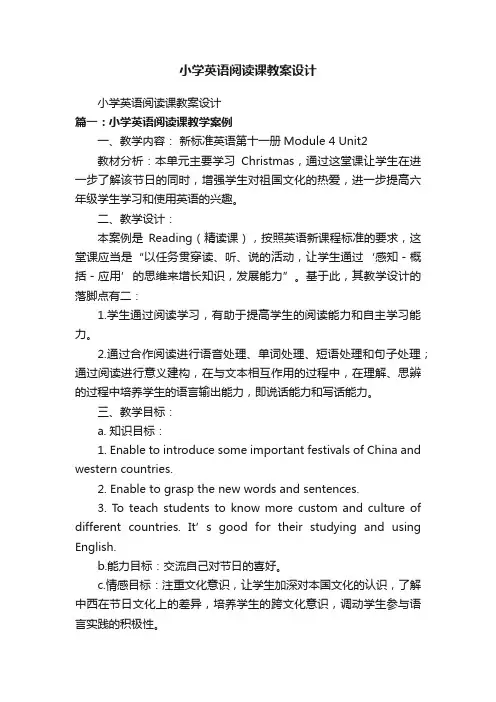
小学英语阅读课教案设计小学英语阅读课教案设计篇一:小学英语阅读课教学案例一、教学内容:新标准英语第十一册Module 4 Unit2教材分析:本单元主要学习Christmas,通过这堂课让学生在进一步了解该节日的同时,增强学生对祖国文化的热爱,进一步提高六年级学生学习和使用英语的兴趣。
二、教学设计:本案例是Reading(精读课),按照英语新课程标准的要求,这堂课应当是“以任务贯穿读、听、说的活动,让学生通过‘感知-概括-应用’的思维来增长知识,发展能力”。
基于此,其教学设计的落脚点有二:1.学生通过阅读学习,有助于提高学生的阅读能力和自主学习能力。
2.通过合作阅读进行语音处理、单词处理、短语处理和句子处理;通过阅读进行意义建构,在与文本相互作用的过程中,在理解、思辨的过程中培养学生的语言输出能力,即说话能力和写话能力。
三、教学目标:a. 知识目标:1. Enable to introduce some important festivals of China and western countries.2. Enable to grasp the new words and sentences.3. To teach students to know more custom and culture of different countries. It’s good for their studying and using English.b.能力目标:交流自己对节日的喜好。
c.情感目标:注重文化意识,让学生加深对本国文化的认识,了解中西在节日文化上的差异,培养学生的跨文化意识,调动学生参与语言实践的积极性。
四、文化意识:简单了解世界各国不同的节日文化.五、教学重点:1. Enable to grasp the sentences of “It’s a very important festival.”2. Enable to grasp the new words: present,3. Enable to introduce some important festivals of China and western countries.六、教学难点:1. Enable to describe the customs of Christmas and other festivals.2. To use the words of months to introduce the festivals well.七、教学资源:多媒体教学课件、卡片、图片、CD-ROM、录音机、八、教学过程:(一)热身导入:1.师生通过问答进行口语交际,如:How are you ?What day is it today ?What's the weather like today? Whose your friend ?What’s your favourite festival?(设计说明:阅读短文前先通过Greeting和师生问答,让学生立刻融入到英语学习的氛围中,无形中拉近了师生之间的距离,为接下来的短文阅读做好铺垫。
小学六年级英语阅读课《Travel to Australia》教学设计《 Travel to Australia》教学主一、教材分析本的教学内容是合PEP 小学英教材自主写的一篇文本,是一小学六年。
文本Australia 展开,主要介了澳大利的面、人口和著名的物。
篇内容生有趣,既丰富了学生的地理知,又开了学生的野,很好地体了英学科工具性和人文性的一。
但同它也有篇幅,生多,表达内容有一定度等特点,于六年学生的来有一定的挑性。
二、学生分析六年英在小学英教学中起着承上启下的作用,既是五年的延伸又是初中一年的。
学生三年多的英学,已具了一定的听写言技能和合言运用能力,形成了良好的英学,保留着英学比厚的趣。
六年的学生具了一定的理解能力,在日常学中已掌握了的策略和方法。
三、教学目1.Make Ss know some new words and phrases: population, the same as, famous for, the past forms of some verbs.2. Can use the sentences:⋯is a⋯It countryis⋯. than China. Its population is⋯It ’ s famous for⋯3. To encourage the Ss to use the simple sentences to describe the countries.四、教学境□易多媒体教学境□交互式多媒体教学境√□网多媒体教学境□移学□其他五、信息技用思路(突出三个方面:使用哪些技?在哪些教学如何使用些技?使用些技的期效果是?)200 字1 、主要使用的技:Voki 平台、 Tagul文本云定制、Screedbot2 、 Warming up 利用Voki 平台入一个美国朋友到澳大利旅游的情景,更加直形象,生有趣。
新授利用Tagul文本云定制,学生通察文本云,建构支架,合关逐步理解文本。
2024年英语阅读课教学设计全英教案LessonTitle:TheMagicofReadingObjective:Todevelopstudents'readingskills,includingskimming,scanni ng,anddetledreading.Toenhancestudents'vocabularyandprehensionofdifferentgenr esoftexts.Tostimulatestudents'interestinreadingandencouragethemtor eadforpleasure.Materials:Textbook:"Englishforthe21stCentury"JohnSmithHandouts:Vocabularylists,prehensionquestionsWhiteboardandmarkersWarm-up(5minutes)Begintheclassaskingstudentstosharetheirfavoritebooksandw hytheyenjoyreadingthem.Discussbrieflytheimportanceofreadinginlifeandthebenefits itbrings.Introduction(10minutes)Introducethetopicofthelesson:TheMagicofReading.Explntheimportanceofreadingdifferentgenresandhowitbroade nsone'sperspective.Presentthemnideaofthelesson:Readingisamagicaljourneythat takesustodifferentworldsandteachesusvaluablelifelessons.SkimmingandScanning(15minutes)Dividetheclassintosmallgroupsanddistributethefirstreadin gpassage.Instructstudentstoskimthepassagequicklytogetthemnideaand scanforspecificinformation.Givestudentsafewminutestoworkintheirgroupsandthenaskthem tosharetheirfindings.DetledReading(20minutes)Providethestudentswiththesecondreadingpassage.Guidethemthroughadetledreadingofthetext,focusingonprehen sionandvocabulary.Usequestionstocheckforunderstandingandencouragestudentst oexplntheirthoughts.VocabularyBuilding(15minutes)Presentalistofnewvocabularywordsrelatedtothereadingpassa ge.UsetheTPR(TotalPhysicalResponse)methodtohelpstudentslear nthewordsthroughphysicalactions.Havestudentscreatesentencesusingthenewvocabulary.ComprehensionQuestions(10minutes)Distributeasetofprehensionquestionsbasedonthereadingpass age.Instructstudentstoworkindividuallyandanswerthequestions.Gothroughtheanswersasaclass,discussinganymisconceptionso rmisunderstandings.GroupDiscussion(10minutes)Dividetheclassintoprsorsmallgroups.Askstudentstodiscussthefollowingquestions:1.Howdoesreadingaffectyourlife?2.Whataresomechallengesyoufacewhenreading?3.Howcanweoverethesechallenges?Encouragestudentstosharetheirthoughtsandexperiences.ClosingActivity(5minutes)Concludethelessonsummarizingthekeypointsdiscussed.Askstudentstoreflectontheirlearningandshareonethingtheyf oundmostinterestingorhelpful.Assignahomeworktask:Studentsarerequiredtoreadashortstory oftheirchoiceandwriteabriefsummaryofthestoryinclassthefollo wingday.Assessment:Evaluatestudents'readingskillsthroughtheirparticipationi nclassactivitiesandtheiranswerstoprehensionquestions.Monitortheirprogressinvocabularybuildingandtheirabilityt ousenewwordsinsentences.Note:Thislessonplancanbeadjustedaccordingtothespecificne edsandlevelofthestudents.Additionalresourcesandactivitiesca nbeincludedtocatertodifferentlearningstylesandpreferences.重难点补充:教学过程中的重点在于培养学生的阅读技巧,特别是快速阅读(skimming)和细节阅读(detledreading),以及提高他们对不同文本体裁的理解能力。
英语阅读课英语教案【篇一:小学五年级四单元英语阅读课教案】小学英语阅读课教学的模式1) preparation 准备活动目的:热身,复习方式:相关内容的song,chant,tpr,free talk等2) pre-reading 阅读前活动目的:排除障碍,降低阅读难度方式:(1) 在情景会话中渗透自然新语言(可进行阅读预测)(2) 在游戏中理解新词或语言,给学生阅读提示3) in-reading 阅读中活动目的:培养学生获取信息和处理信息的能力方式:设置由易及难的任务,进行由略到细的阅读4) post-reading阅读后活动目的:在真实自然的任务型活动中扩展运用阅读信息方式:(1)分层合作(2)说写训练5) progress 发展提高目的:发展,提高方式:总结,自我评价、小组评价,检测,作业布置下面就以五年级上(a) unit 4 read and write为例,具体示例如下:1、preparation.准备活动。
l目的:热身,复习l方式:相关内容的song,chant,tpr,free talk等例1:(1) sing a song : i can help(替换)(2) chant: xx,xx, what can you do ? (替换吟唱本单元第一段chant :xx,xx, what can you do ? i can do, do the dishes?以此形式复习已学的动词词组)(3)chain game:i can ?. what can you do? (任意回答:i can run/ paint?)例2:将阅读材料里的情节编成故事先猜猜说说,复习语言,激发兴趣。
把小动物们做家务的图装订成册: little monkey, little monkey, what can you do? 猜一猜后再翻出答案 i can sweep, sweep the floor. look at me! 依此类推??2、pre-reading阅读前活动。
英语阅读教学设计课说课稿一、课程简介本节课是一节针对英语阅读教学的课程。
通过这节课,学生将学习如何有效地阅读英语文本,并提高他们的阅读理解能力和词汇积累能力。
本课程适用于初级英语学习者,教学时间为45分钟。
二、课程目标1. 培养学生的英语阅读兴趣,提高他们的阅读能力。
2. 帮助学生学会运用不同的阅读策略,提高阅读理解能力。
3. 增强学生的词汇积累能力,丰富他们的词汇量。
4. 发展学生的独立思考和问题解决能力。
三、教学重点1. 学会使用不同的阅读策略。
2. 增加学生的阅读量,提高阅读速度。
3. 锻炼学生的阅读理解能力。
四、教学准备1. 教师:教师教材、学生教材、课件、活动手册等。
2. 学生:学生教材、课堂笔记、字典等。
五、教学过程1. 创设情境(5分钟)在课堂上展示一张图片,引起学生对阅读的兴趣。
提问学生对这张图片的看法,并鼓励他们进行简单的交流。
2. 导入新知(10分钟)使用课件,向学生介绍不同的阅读策略,如扫读、略读、详读等。
解释每种策略的作用,并给予相应的例子。
3. 阅读活动(20分钟)将学生分成小组,每个小组发给一篇适合他们水平的短文。
要求学生按照不同的阅读策略进行阅读,鼓励他们在阅读过程中做好记录,如标记关键词、划出重点句子等。
同时,教师可以在学生阅读过程中给予适当的指导和建议。
4. 分享讨论(10分钟)每个小组选派一名代表,向全班分享他们的阅读体验和收获。
教师引导学生进行问题解答和互动讨论,扩展学生的阅读视野和知识面。
5. 总结归纳(5分钟)教师对本节课的教学内容进行总结,并引导学生进行思考和反思。
鼓励学生提出他们在阅读过程中遇到的问题和困惑。
六、课后作业1. 要求学生每天阅读英语文章,积累词汇和提高阅读速度。
2. 学生需要写一篇关于他们喜欢的英语文章的读后感,包括他们的理解和感受。
七、教学反思本节课主要通过任务型活动的方式培养学生的英语阅读能力。
学生在小组中进行合作,提高了他们的自主学习和解决问题的能力。
1
英语阅读课教学设计
滨海县大套中学 水克祥
一、教材依据
本课时选择的是《牛津初中英语》七年级上Unit4 Food,主要围绕本
单元中心任务“Food and lifestyles”而展开的。这篇文章主要讲述了Kitty
和Daniel过去和现在的饮食和生活习惯,通过比较,让学生明白什么是健
康饮食和生活习惯。
二、教学原则与理念
1 实行课堂教学任务化,任务生活化,评价方式过程化,以学生为主体,
以话题为主线,以任务为中心。
2 教学设计突出学生的主体地位,尊重学生个体差异。
3 灵活使用、整合教学资源,优化教学效果。
三、教学目标
1.知识目标:
(1)词汇:扩展有关食物和生活方式的词汇
(2)日常交际用语:1. What is your favorite food?
2. I like/dislike……
2.能力目标
(1)根据图片猜测大意
(2)掌握模仿主题进行描述的技巧,练习了解文章大意,快速浏览查找
细节的快速阅读技巧
3.情感目标
创造机会,鼓励学生用所学的英语知识合作交流,共同完成任务 ,
使他们体验成功,激发学习英语兴趣。
4.德育目标
通过本文学习增强学生健康意识,使他们明白生活中不能挑食,要
珍惜粮食,养成优良的生活方式。
四、教学重点
掌握文章中的词汇和理解课文内容,掌握阅读的技巧。
五、教学难点
2
明白健康饮食和优良生活习惯的重要性
六、教学准备
1. 教师:挂图、录音机、小黑板、实物(水果、素菜、饮料……)
2. 学生:课前词汇预习;健康食物、生活习惯资料收集笔录。
七、教学过程:
Step 1: Warming –up(热身)
(一)Free Talk: To ask the student on duty to make a speech : “What is my
favourite food ?”
设计思路:
每天都有值日生报告,可以锻炼学生的书写和口头表达能力,另外,在
交流过程中,也互相锻炼了学生的听力水平。同时,活跃了课堂气氛。
(二)1. Revise some names of food (Let the students speak freely.)
2. To show the students beautiful pictures of food during the talking .The
teacher can write some of them on the blackboard, especially some new
words: fruit, sweet, coke, bread, meat, juice.
3. To ask the students to ask and answer :“What is it ?”,“Do you like
it ?” ,then discuss: “(1)What food can we eat a lot ? (2) Which is
your favorite food? Why?
设计思路:
(1)让学生自由回答,复习已学了的食物名称,满足学生表现的欲
望,进一步活跃课堂气氛,调动学生积极性。
(2)通过形象直观图片教学,激活旧知识,为学习新知识做铺垫。
(3)通过有趣的话题极大地激发学生的好奇心,为进入正文教学打
下基础。让他们参与初步讨论,知道哪些才是正确的饮食。
Step 2: Pre-listening(听读)
1. First, let the students look at the photos on Page 60.
2. Second, listen to the tape and read the articles about Kitty and Daniel
and tell the teacher who is healthy.
设计思路:
听和读都是获取信息的有效途径,通过边听边读(默读)初步感知文
章内容培养学生快速概括文章主题能力。
3
Step 3: Skimming and Note-taking(速读和速记)
1.What does Kitty want to be?
2.What does Kitty eat for breakfast now ?
3.What does Daniel like eating?
4.What does Daniel plan to do?
设计思路:
通过有目的听读,让学生了解文章大意同时把握文章中一些细节内容,
培养学生阅读技巧,通过有目的地快速浏览文章,解决一些文章中较简单
直观的题目。
Step 4:Scanning(审读)
Read the text again; try to answer the questions below:
1. How long does kitty dance every day?
2. How does she feel when she dances?
3. What is important for her?
4. What does she have for dinner?
5. What does Daniel like doing?
6. Does Daniel have a healthy diet or lifestyle? Why?
7. Can he run fast? Why?
8. What does he plan to do?
设计思路:
进一步有目的的阅读,可以更好的理解文章细节,培养学生做细节题
目的能力,同时以竞赛的形式进行能更进一步激发学生地主动参与。
Step5:Explaining main and difficult points(释疑)
Let the students work in groups and find out the difficult points, then tell
the teacher.
设计思路:
在限定时间内划出疑难问题,在组内讨论,互相启发,教师巡查,给
学生提供及时帮助,然后小组向全班陈述本组难题,教师根据各组信息反
馈,通过典型例句精讲重难点,培养学生独立思考问题、解决问题的能力
和合作探究精神。
Step6: Communication and Application(交流与应用)
4
1. To ask the students to retell the story
2. The teacher give them a topic: “how to keep healthy”
设计思路:
1. 复述文章有助于培养学生语言运用能力,同时锻炼学生听说能力
2. 学以致用,话题贴近生活,可以对学习英语产生更大的兴趣,同
时,通过这项活动可以充分训练学生英语综合技能。
Step7:Summary and Check-up(归纳与总结)
1. T:What have you learned from this class? What should you do?
2. Main points(略)
Step8:Homework(作业)
1. 思考:What food is (not) healthy?(归类)
2. 写作:How to keep healthy?
3. 查找:1)vitamin类型及其作用(Internet)
2)采访父母亲戚怎么样保持健康
设计思路:
1. 布置总结归类性作业需要学生通过交流、辨别找出它们的共同点
和不同点,锻炼了学生辨别是非的能力。
2. 把课堂上讨论交流的话题总结整理成文章,可以全面检测教学效
果,同时也是课堂教学的延伸。
3. 采访类性作业需要学生查资料(充分利用好农村刚建设好的“校
校通工程”,丰富学生的知识面,增强学生查找、整合、利用资料
的能力),与他人合作交流,使学生将所学英语知识用于实践,达
到在用中学,学了就用的目的。
八、教学反思
本设计的亮点:以灵活的形式开展教学活动,以培养学生阅读技巧为中
心。学生反应积极,讨论热烈,思维活跃,竞争激烈,教学效果令人满意,
同时过程也合理安排了合作探究活动,让学生共同提高。通过阅读让学生理
解课文内容,形成阅读技能,主要通过“快速浏览、提炼大意、细节捕捉、
交流应用”四个步骤,培养学生概括主题,捕捉细节和再现阅读内容的技能。
教师能注意设计合适的衔接语言,使整个环节过渡自然,让学生轻松学好每
一节课。
5
教师应该更多关注如何使学生掌握阅读技巧,而不是仅向学生灌输大量
的语言知识。教学过程是学生在教师的帮助和指导下掌握知识和形成技能的
过程。活动中发挥学生主体地位,让学生自己去发现问题、分析问题和解决
问题。在教学设计中,我们要考虑学生情感的重要性,要设法让学生在欢乐
的情景下学习,但教师不能一味追求所谓“快乐”,忽略了学生对知识的掌
握和能力的培养。
设计了相应地评价模式,根据小组自学程度、参与度、合作成果、作业
情况等项目制定了一张表格,把每天课内外优胜小组记录下来,一单元结束
后进行总评价、表彰,在课堂上也给予学生相应口头评价,把形成性评价和
终结性评价相结合,让学生能进步更快,学得更快乐。